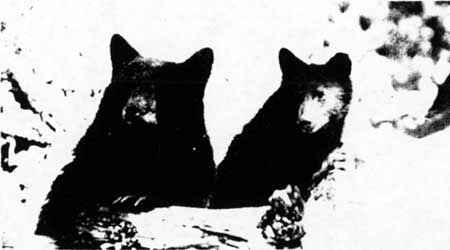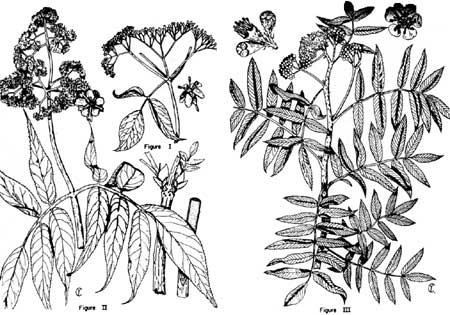
Crater Lake Bears. From kodachrome by Welles and Welles.
Three Similar Shrubs in Crater Lake National Park
By Charles F. Yocom
Visitors in Crater Lake National Park during the latter part of the summer frequently notice the attractive white blooms of certain green shrubs along the Klamath Falls entrance road (south entrance) and along the walks near the Information Building and the Lodge. Ranger naturalists are occasionally asked the name of one of these plants but from the description are usually unable to tell the visitor the exact name of the plant, for there are three different kinds of shrubs in the park that have somewhat similar appearing blooms and leaves. These are blueberry elder, Sambucus coerulea(Fig. I), Pacific red elder, Sambucus racemosa var. callicarpa. (Fig. II), and western mountain ash, Sorbus sitchensis (Fig. III).
Two of these plants, the elderberries, are in the same genus and the leaves and stems look nearly identical. They differ, however, in the shapes of the flower clusters. The blueberry elder has a cluster of flowers that appears somewhat similar in shape to an umbrella, whereas the white flower clusters on the red elder are dome-shaped or somewhat pyramid-shaped. If the branches of either are broken one can see that the stems are filled with a soft substance called pith.
Mountain ash is related neither to the elderberries nor to the ash tree, which it also resembles; but it is closely allied with the wild rose, apple, peach, pear, plum, chokecherry and serviceberry, all of which belong to the rose family. In some areas, mountain ash attains the proportions of a small tree; in Crater Lake National Park, however, it usually occurs as shrubs. The elders belong to the honey-suckle family and should not be confused with alders.
For structural differences between the three shrubs, see the table below. Blueberry elder occurs only along the south boundary of the park and is common along the roadsides between Klamath Falls and Fort Klamath. Mountain ash and red elder occur at higher elevations in the park and often are growing side by side. All of these shrubs furnish an important source of food for many birds and some mammals.
In late summer and fall visitors observe the attractive berries of these shrubs along the roads and walks. There is no difficulty in telling the two elders apart at this time of year, for they have berries colored according to their common names. Of course, those with blue berries (Sambucus coerulea) are found at lower elevations and are often sought for pies and wine. Mountain ash and red elder have berries that look somewhat alike, so one must look for differences in leaves and stems.
Also remember that the cluster of berries of mountain ash is somewhat umbrella-like in shape and that the berry cluster of red elder is oblong, the berries themselves being brighter red.
Comparative Table of the Three Confusing Shrubs
| Character | Mountain Ash | Red Elder | Blueberry Elder |
|
|
|||
| Color of flowers | white | white | white |
| Shape of flower cluster | umbrella-like | dome-shaped or pyramid | umbrella-like |
| No. of petals | 5 | 5 | 5 |
| No. of stamens | more than 5 | 5 | 5 |
| Color of berry | Orange-red | bright red | blue |
| Shape of berry clusters | flat topped cluster | oblong cluster | flat topped cluster |
| No. of leaflets | 9 to 11 | 3 to 9 | 3 to 9 |
| Color of leaflets | shiny green | dull green | dull green |
| Amount of pith in stem | very little | much | much |
Nesting Birds
During the summer, at least several visitors came into the Information Building to inquire about the two blue birds seen near the back of the building. Of those who saw the pair of mountain bluebirds, Sialia currucoides (Bechstein), only a few realized that the birds were nesting behind a half-closed window shutter on the second floor. When the nest, made up of grass, dead staghorn lichen and one piece of twine, was first discovered on July 11, it contained two eggs.
On subsequent visits the female was nearly always seen on the nest, incubating her undersized clutch of eggs. On July 21, two helpless, pink mites were seen for the first time. The babies grew rapidly; 20 days later one was still in the nest but the other had ventured as far as the ledge a foot away. When the nest was visited the following day, both young bluebirds had departed.
Other nests were found during the summer, most of them being located by observing the adults carrying food. In this way, a second mountain bluebird’s nest was discovered in a hole 20 feet up in a mountain hemlock, several hundred feet east of the Lodge.
The nesting hole of a red-breasted nuthatch, Sitta canadensis Linnaeus, also in mountain hemlock, was watched by numerous members of the morning Garfield Peak field trips. The dead stub, to which the nuthatches came regularly with food, was conveniently located near the first lookout along the Garfield Trail.
Mountain chickadees, Parus gambeli Ridgway, were found in a snag at Cold Spring Campground, and a pair of violet-green swallows, Tachycineta thalassina (Swainson), evidently reared a family in a cavity in one of the Wheeler Creek pinnacles. The swallows were observed making frequent trips to a small hole in one of the tall, spire-shaped formations, presumably feeding their young.
The nests of two Oregon juncos, Junco oreganus (Townsend), were discovered quite by accident when, in each case, the incubating female was flushed from her nest, well-hidden in a depression in the ground. One nest contained three eggs, the other held four; both were located between the highway and lower Munson Meadow. Unfortunately, there was not an opportunity to observe the hatching and growth of the young. Perhaps our visits were too frequent, perhaps some catastrophe overtook the females. At any rate, the nests were abandoned and neither adult was seen again in the immediate vicinity.
References
Farner, Donald S. 1952. The Birds of Crater Lake National Park. University of Kansas Press. ix, 190 pp.
Farner, Donald S. 1952. The use of the Wheeler Creek Pinnacles by nesting birds. Crater Lake Nature Notes 18:9-10.


